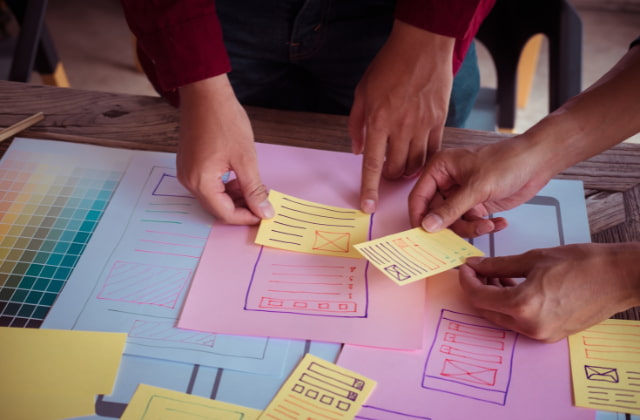How Service Design Can Transform Public Sector Performance
 Matthew Kavanagh
·
4 minute read
Matthew Kavanagh
·
4 minute read
In today’s modern world, public sector organisations face mounting pressure to deliver efficient, budget-friendly services to their users.
However, many organisations can struggle to keep pace with changing expectations and evolving needs.
That’s where exceptional public sector service design comes in.
In this blog, we’ll explore the benefits of service design for public sector organisations and how it can help them overcome common challenges, reduce costs and significantly improve user satisfaction. We’ll share the key elements of service design and provide practical advice for overcoming barriers to implementation.
By the end of this post, you’ll have a better understanding of how great service design can transform public sector services.
What is Service Design?
Service design is a discipline and practice that combines principles of customer experience and business process mapping that puts the user experience at the heart of decision-making. It’s about focusing on the user journey and aligning your systems to make that journey as smooth and fulfilling as possible.
It's typically used in the private sector to improve customer satisfaction and a 2018 McKinsey report on service design indicates that companies with a design-centred approach can enjoy a 32% points higher revenue growth over those that don’t focus on the power of good service design.
In much the same way, the same principles and design tools can be utilised effectively across public services, whether that's central government, health services or local authorities.
3 Benefits of Service Design for the Public Sector
Public sector organisations have the perennial issue of trying to deliver high-quality services within challenging budget constraints. Service design offers a user-centric approach to processes that can help organisations overcome this issue by creating public services that better meet the needs and expectations of their users. The benefits of improved service design are numerous and include:
1. Improved user satisfaction
Looking at services through the service design lens helps to identify pain points in the user journey and create services that address them. This leads to a more seamless and effective service experience that improves user outcomes and satisfaction. In contrast, bad service design can cause a significant reputational hit, with research suggesting 44% of users will tell friends about a bad online experience.
2. Reduced costs and improved efficiency
A service design approach helps organisations streamline their operations and remove unnecessary or unintuitive steps in the service delivery process. This can reduce errors and inefficiencies, as well as free up time and resources to be better used elsewhere.
3. Increased innovation and creativity
By looking at your services from a new user-focused perspective, you can discover new ways to meet their needs and improve your services. Involving stakeholders from across your organisation in the service design process will provide insight into how the service journey can be better delivered at every step of the way.
For example, Gov.UK Notify is a service that enables government workers to send messages to members of the public. The team behind it used contextual research to find out that staff would often need to send one-off texts to members of the public while speaking to them over the phone. By observing and understanding how workers need to interact with their service, they were able to uncover a new area for improvement and develop a new interface that makes these one-off messages easier and more efficient.
Getting Started with Effective Service Design
If you’re going to build a service around your users, the first thing you need to do is make sure you know who they are, what they need and how you can effectively apply design to meet that need.
User Research
Understand the service journey your users go through by conducting user research. As the government’s own service manual puts it: “Focusing on the user and the problem they’re trying to solve - rather than a particular solution - often means that you learn unexpected things about their needs.”
Surveys and interviews with users can help you gain insight into how users engage with your service. If you can understand how your service is used, what challenges users face and what they would like to see improved, you’ll have the right foundation to start making impactful changes.
Mapping the Service Journey
Every journey is easier with a map and service design is no different. If you want to implement a holistic approach to your service, you need to fully understand the user journey. This means understanding the “frontstage” journey (how the user experiences the service) as well as the “backstage” effort (the processes and workflow that drive the service).
Service design is all about marrying these two elements together to improve the experience and doing that is a lot easier if you produce a service blueprint.
This means visually mapping out the user journey from the start to achieving their goal in order to understand what processes (whether visible to the user or not) they need to get through to achieve it.
By doing so, organisations gain a powerful birds-eye view of the user experience. This can let them identify weak points, such as a long processing time for a form, and figure out how to better optimise their processes and improve the service user’s experience.
For the public sector where services might involve multiple departments or organisations, a comprehensive service blueprint can help different teams to better understand each other, and deliver a more effective service.
Overcoming Barriers to Improved Service Design in the Public Sector
While implementing better public sector service design has the potential to greatly improve services for users, there are several barriers that can make it difficult.
Public sector organisations are often working with limited budgets, reduced staff numbers or overwhelming design. When a lot of organisations have to prioritise putting out fires, it can be difficult to find the time, money or enthusiasm for big changes.
Additionally, many organisations will have complex or legacy systems that can be a significant roadblock to change. This can also cause resistance to change and a lack of buy-in from stakeholders who might be set in their ways. Overcoming these barriers is possible and can lead to long-term cost reductions and improved user satisfaction.
Start Small
Implementing service design on a small scale can be an excellent way of demonstrating its value and how it works. Focus on a small, simple service or area and build a service design framework that works and can be scaled up. The best way to get buy-in from key stakeholders is to prove your plan works.
Involve Stakeholders Early On
Implementing a holistic approach to service design can only work if stakeholders involved throughout the service are included enthusiastically. Conduct user research, engage in collaborative sessions with stakeholders who will be part of the service you’re designing and be receptive to their views and experience.
Build a Service Design Culture
To successfully transform their services, public sector organisations should aim to build an organisation-wide culture that values user-centric design and innovation. Training, consistent design philosophy and strengthening cross-functional communication will help foster creative, user-focused service design.
By implementing service design methodologies and building a culture that values user-centric design and innovation, public sector organisations can create truly exceptional services that meet the needs of their users.
Service Design is a Powerful Tool to Improve Service, but it's Only the Beginning
Explore our diverse range of Service Improvement Courses to find more ways to provide amazing service for your users.





%20compressed-1.jpg)

